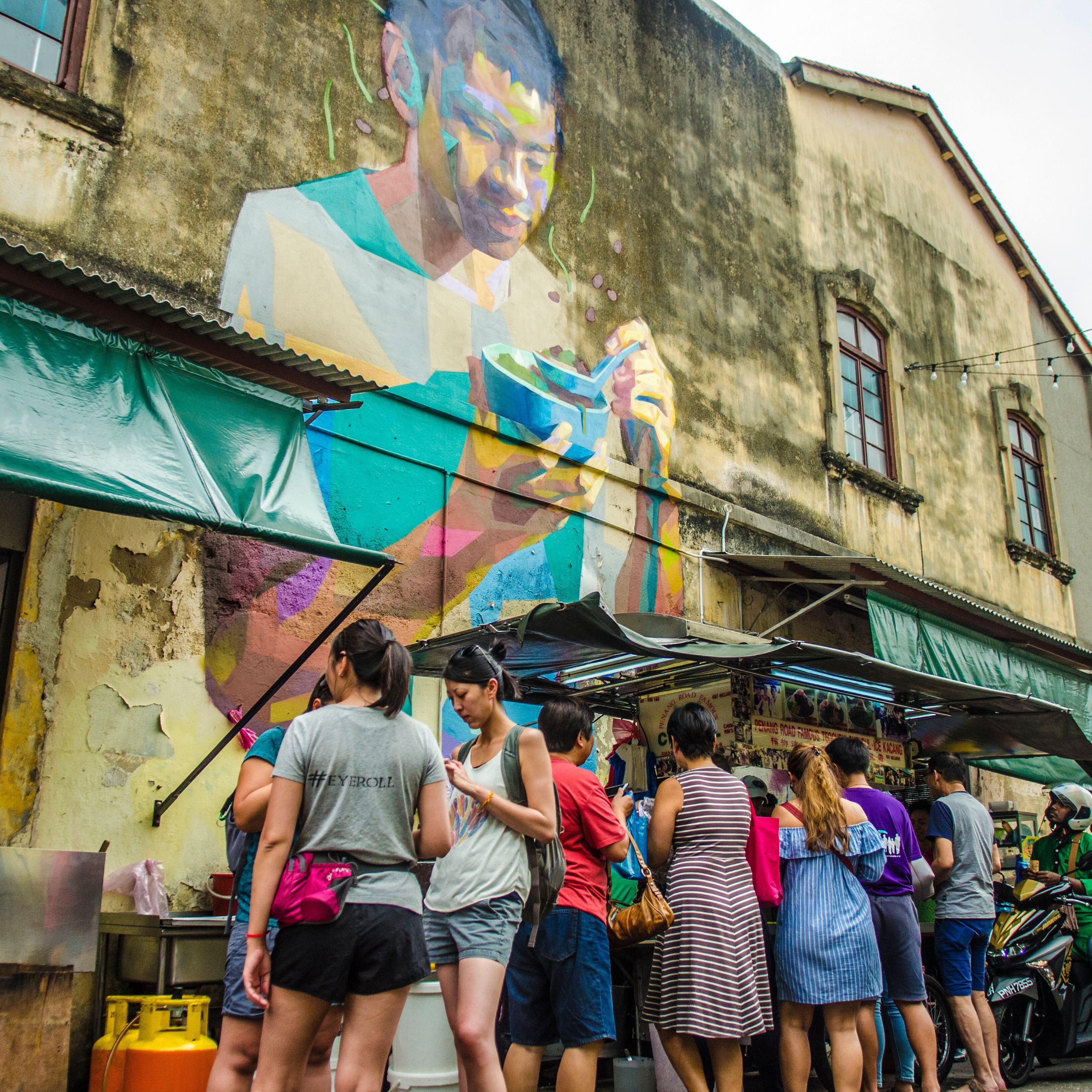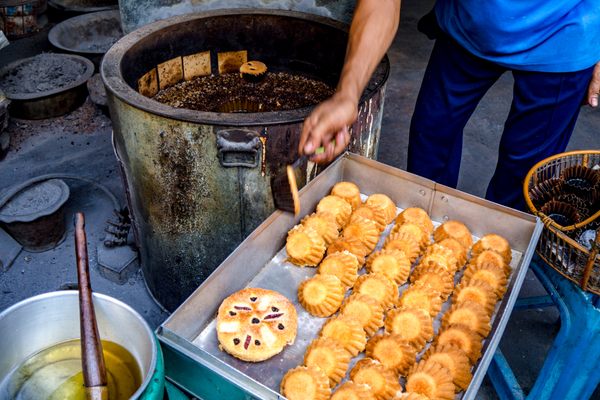

A Gastro Obscura Guide to Penang
The tropical trading hub is home to delicious diasporas, fantastic fruit, and sumptuous snacking.
Tropical Penang, located in northwest Malaysia, is known for having one of Asia’s best street food scenes, boasting delicacies from tangy assam laksa to otak otak, a spiced fish cake that is unique to Penang for being steamed, not grilled. But Penang’s culinary history encompasses more than bustling hawkers and food courts. For centuries, explorers made their home here, bringing an assortment of cooking traditions that bloomed in Penang’s melting pot.

Peranakan Provisions
Starting as far back as the 14th century, fortune-seekers from China arrived to trade on the island, eventually marrying local Malay women. This marked the rise of the Straits Chinese Peranakans, known in Penang as the Baba Nyonya. This fusion of Malay and Chinese culture shines in the cuisine, which is dominated by the Peranakan women, known as Nyonya. In their hands, ingredients native to the Malay Peninsula, like buah keluak (whose flavor chefs liken to truffles), blend with Chinese ingredients, like the fermented soybean paste taucheo.
Due to its proximity to Thailand and use of ingredients like tamarind, this style, known as Peranakan Nyonya cuisine, boasts a more sour flavor profile compared to its Peranakan cousins in Malacca, Singapore, and Indonesia. Nowhere is this more evident than in the fragrant gulai tumis, a hot-and-sour fish curry that takes the spotlight at Auntie Gaik Lean’s Old School Eatery, a Michelin-starred restaurant helmed by the titular Beh Gaik Lean, herself a fourth-generation Nyonya. For decades, Auntie Gaik Lean has been perfecting her recipes, which shines in her menu in dishes like the delicately crunchy kuih pai tee and nasi ulam, a rice dish packed with several varieties of finely-chopped fresh herbs, including daun kesum (Vietnamese mint leaves, or laksa leaves), daun kaduk (wild betel leaves), and lemongrass.

Sumptuous Snacking
To further appreciate the Nyonya’s ability to balance rich flavors and textures, step into the world of Nyonya kuih—a category of Southeast Asian snacks that can range from steamed spongy cakes to savory translucent dumplings to lightly baked puddings. Kuih’s ingredients can include various combinations of gula melaka (a local palm sugar), sago (a starch extracted from tropical palm stems), pandan, coconut, or butterfly pea flower, though other sweet and savory ingredients such as sweet potato and dried shrimp can take a starring role.
The Pinang Peranakan Mansion, a museum that offers a slice of Peranakan history, provides an introductory course for the kuih curious. Its café, Nyonya Palazzo, serves a kuih platter that includes kuih seri muka, a steamed layer cake consisting of a glutinous rice base and a pandan custard top, and gao teng kuih, a nine-layered treat that boasts thinly steamed colored layers of sweet coconut milk and rice flour. But if you’d like to dive even deeper into the world of kuih, a treasure trove of options awaits at Moh Teng Pheow, an unassuming eatery hidden on a side street. Operations date back to 1933, making the store one of Penang’s oldest-running kuih makers; even today, the staffers wake up at 6 a.m. to carefully hand-make the delicate treats. With up to 30 to 40 types of kuih to choose from, visitors have a variety of delicious paths to take, but here are two suggestions: pulut tai tai, coconut-flavored glutinous rice pressed together into neat squares and topped with a dollop of nutty coconut jam, and kuih koci, a glutinous rice dumpling that contains shredded sweet coconut and warm, caramel-like palm sugar.

Indian Influences
It wasn’t just the Chinese immigrants coming to Penang. Traders from India also sought their fortunes here, settling along Chulia Street in the 18th century. Like the Chinese, these Indian traders married local Malay women, giving rise to the Jawi Peranakan community. The Jawi Peranakans—Jawi being an Arabic word denoting Southeast Asian Muslims—would later grow in definition to include Arab-Malay descendants. This fusion emphasized distinctly Indian and Middle Eastern twists on classic Malay dishes by weaving in ingredients native to their lands, including rose water, saffron, and dried fruits.
Jawi Peranakan cuisine was deemed so rich, in fact, that for years, it was seen as a lavish option that was mainly served at celebrations. Luckily, with a visit to Jawi House, you can now experience this cuisine without pomp and circumstance. The restaurant, which dates back six generations, was established by the Karim family, of Punjabi-Jawi Peranakan lineage, and is today helmed by their descendant, chef Nurilkarim Razha. The extensive menu celebrates Razha’s Jawi Peranakan heritage, including the earthy, herbaceous rice dish nasi lemuni, and lamb bamieh, a fragrant Persian-inspired okra and lamb stew that boasts a warm tomato base.

But Penang celebrates the Indian influences that helped shape its cultural identity in ways beyond Jawi Peranakan cuisine. To take a bite out of this history, visit the Temple of Fine Arts, which for almost 40 years has encouraged Indian youth to rediscover the cultural, artistic, and spiritual wealth of their ancestors. This celebration of Indian culture extends to its in-house restaurant, Annalakshmi, a semi-open dining space fringed by traditional sculptures and lush, hanging plants.
While it used to serve only the youth who visited the Temple of Fine Arts, today it’s open to the public and offers delectable home-cooked dishes that are exclusively vegetarian, with some going full vegan. The menu rotates every six weeks, but every Friday, the canteen hosts a different regional menu focusing on a specific region of the Indian subcontinent, from north to south. Try to visit when they’re serving paal appam, rice and coconut milk–based pancakes, and pasembur, a sweet and spicy salad.

Hidden Hakka Gems
As you’re browsing the many hawker stalls that pepper the island for your next fix of street food, keep an eye out for one specific dish: yong tau foo, which consists of tofu stuffed with ground meat or fish paste. This dish is a hallmark of the Hakka community, a group of people thought to have originated from northern China, but due to war and persecution, were forced to migrate and scatter across China, and later, Southeast Asia.
For curious explorers eager to earn another feather in their culinary cap, there are some unusual ways to get a taste of Hakka food beyond hawker stalls. One such option, located just outside of George Town’s heritage center, is the family-owned Lao Hakka Restaurant, nestled inside the 90-year-old Chinese Swimming Club in Tanjung Bungah. The restaurant is open to the public, so walk past the lockers and swimming pool to take a seat and tuck into home-cooked dishes like suan pan zi, a Hakka classic where the noodles are shaped into flat discs resembling Chinese abacus beads.
But for the adventurer looking for more of a challenge, head west to Balik Pulau, Penang Island’s western, more rural side. A quick Jeep ride up 300 feet above sea level will get you to Hakka Village, a restaurant serving traditional Hakka dishes. The menu changes every day, offering guests a chance to try classic dishes like fragrant, marinated, taro-braised pork or bitter melon–braised chicken. For groups of 10 or more, they also offer classic Hakka dishes like leicha, a savory soup known as “thunder tea” that dates back centuries and involves finely grinding together herbs, tea, and rice.

Botanical Bounties
Penang has long been a space for different global cultures to take root—and at the Penang Tropical Fruit Farm, located in the northwest corner of Teluk Bahang, that sentiment is taken literally. Featuring an assortment of fruits from around the world, the farm claims to have the largest collection of fruits in Southeast Asia, with over 200 species of edible fruits populating the farm’s sprawling 25 acres.
While available fruits differ depending on the season, a tour will always provide a quick gastronomical trip around the world. Various fruit offerings include nam-nam, a sweet, aromatic fruit native to the Malay Peninsula; jaboticaba, a Brazilian tree with tart, grape-flavored fruits growing directly out of its trunk and branches; and miracle berries from West Africa that can temporarily alter taste buds, turning sour foods sweet on the tongue. At the end of the tour, visitors can sample some of the farm’s fruits while overlooking the lush, verdant jungles.
Snag a few fruits at the end of the tour, then head east, back to George Town. As you tuck into your next meal, see if you can identify the different threads of culinary influence weaving through your food—everything here, after all, is one delicious pastiche of flavor.

Gastro Obscura covers the world’s most wondrous food and drink.
Sign up for our regular newsletter.






















Follow us on Twitter to get the latest on the world's hidden wonders.
Like us on Facebook to get the latest on the world's hidden wonders.
Follow us on Twitter Like us on Facebook